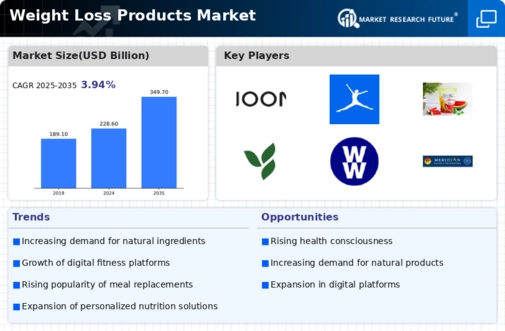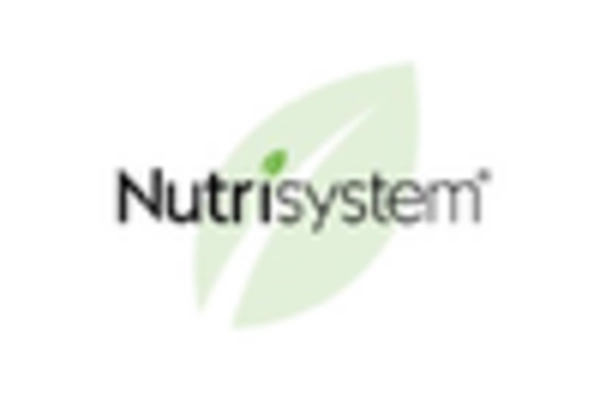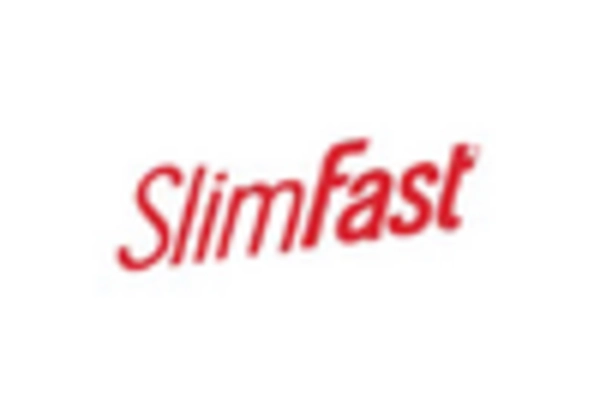Increasing Obesity Rates
The prevalence of obesity continues to rise, prompting a heightened demand for effective weight loss solutions. According to recent statistics, approximately 36 percent of adults are classified as obese, which has led to a surge in the Weight Loss Products Market. This alarming trend is likely to drive consumers towards various weight loss products, including supplements, meal replacements, and fitness programs. As individuals seek to combat obesity-related health issues, the market is expected to expand significantly. The increasing awareness of the health risks associated with obesity, such as diabetes and cardiovascular diseases, further fuels the demand for weight loss products. Consequently, companies within the Weight Loss Products Market are innovating to offer diverse solutions tailored to meet the needs of this growing consumer base.
Rising Health Consciousness
There is a notable shift towards health consciousness among consumers, which is influencing their purchasing decisions. As individuals become more aware of the importance of maintaining a healthy lifestyle, the Weight Loss Products Market is experiencing a corresponding increase in demand. This trend is reflected in the growing popularity of organic and natural weight loss products, as consumers seek alternatives that align with their health goals. Market data indicates that the demand for plant-based supplements and low-calorie meal options is on the rise, suggesting a shift in consumer preferences. This heightened focus on health and wellness is likely to drive innovation within the Weight Loss Products Market, as companies strive to develop products that cater to the evolving needs of health-conscious consumers.
Growing Demand for Convenience
The fast-paced lifestyle of modern consumers is driving a growing demand for convenient weight loss solutions. Busy schedules often leave little time for meal preparation and exercise, leading individuals to seek out products that fit seamlessly into their lives. The Weight Loss Products Market is responding to this trend by offering ready-to-eat meals, meal replacement shakes, and on-the-go snacks that cater to the needs of time-strapped consumers. Market data suggests that the convenience food segment is expanding rapidly, with a significant portion of consumers willing to invest in products that save time while supporting their weight loss goals. This shift towards convenience is likely to shape the future of the Weight Loss Products Market, as companies innovate to provide solutions that align with consumer lifestyles.
Technological Advancements in Weight Loss Solutions
The integration of technology into weight loss solutions is transforming the Weight Loss Products Market. Innovations such as mobile applications, wearable fitness trackers, and online coaching platforms are becoming increasingly popular among consumers. These technological advancements provide users with personalized insights and support, enhancing their weight loss journeys. Market Research Future indicates that the use of fitness apps has surged, with millions of downloads worldwide, indicating a strong consumer interest in tech-driven weight loss solutions. This trend suggests that companies within the Weight Loss Products Market must adapt to the digital landscape to remain competitive. By leveraging technology, businesses can offer more effective and engaging products, potentially leading to increased customer satisfaction and loyalty.
Influence of Social Media and Celebrity Endorsements
Social media platforms and celebrity endorsements play a pivotal role in shaping consumer perceptions and driving trends within the Weight Loss Products Market. The rise of influencers promoting weight loss products has created a powerful marketing channel, reaching millions of potential customers. This phenomenon appears to have a significant impact on consumer behavior, as individuals often look to social media for inspiration and guidance on their weight loss journeys. Market analysis indicates that products endorsed by celebrities tend to experience a surge in popularity, suggesting that effective marketing strategies can greatly influence sales. As social media continues to evolve, its influence on the Weight Loss Products Market is likely to grow, prompting companies to invest in digital marketing strategies to capitalize on this trend.


















Leave a Comment